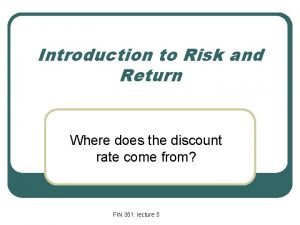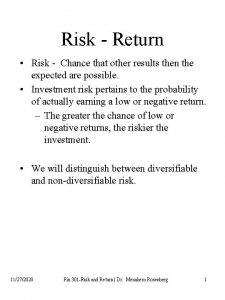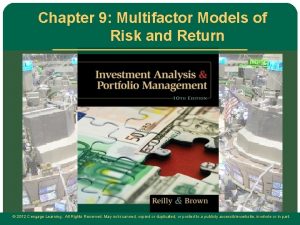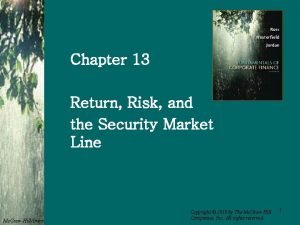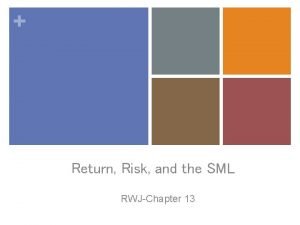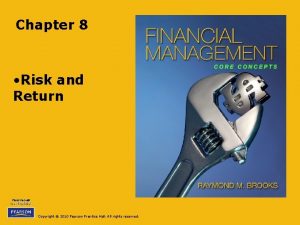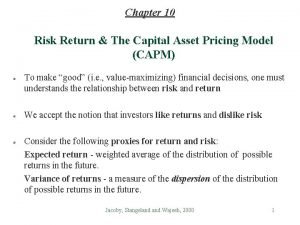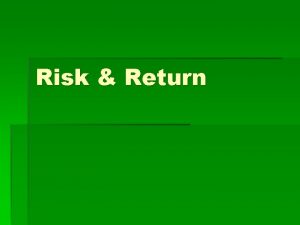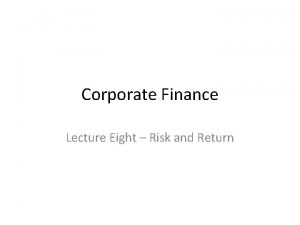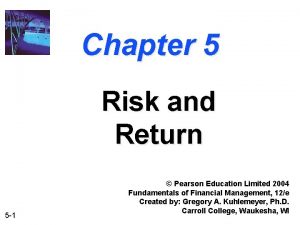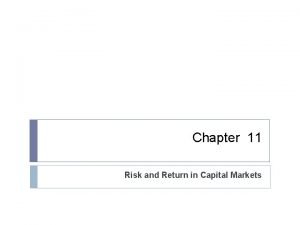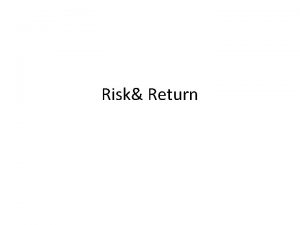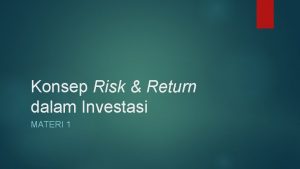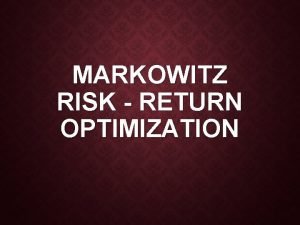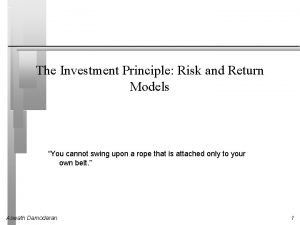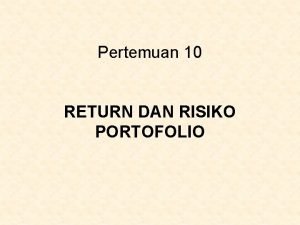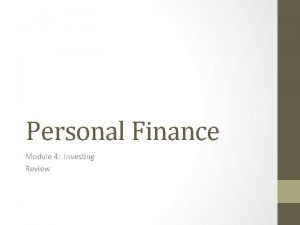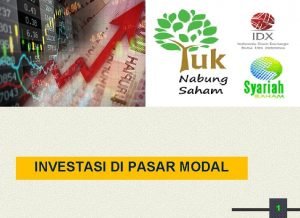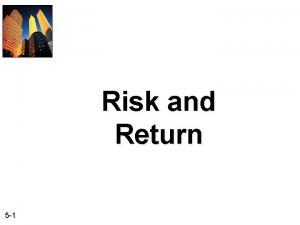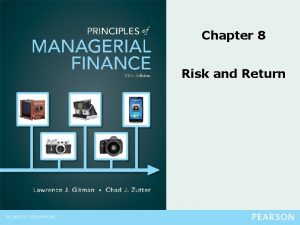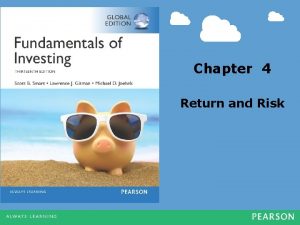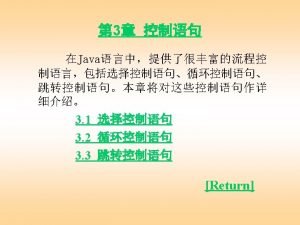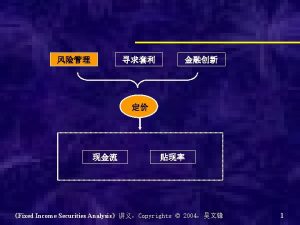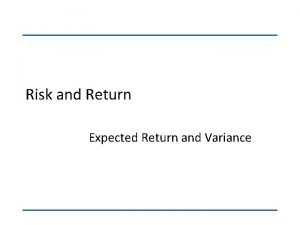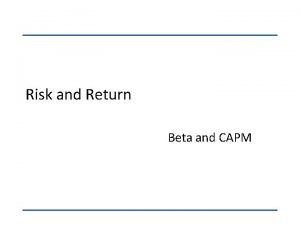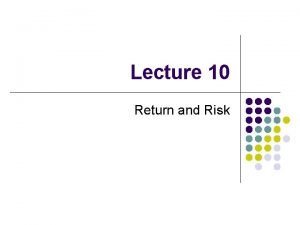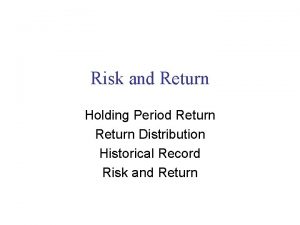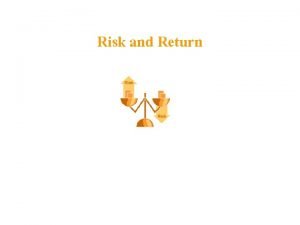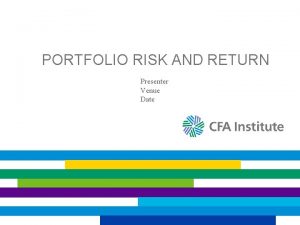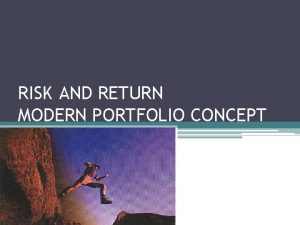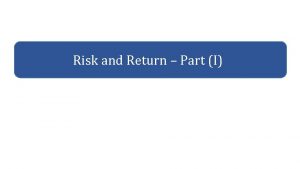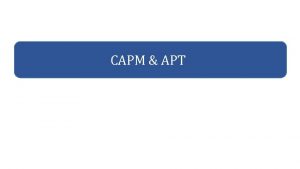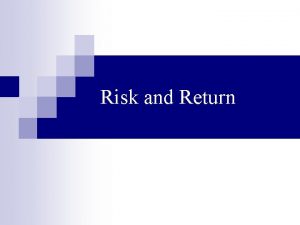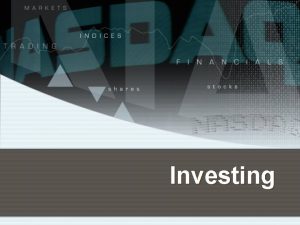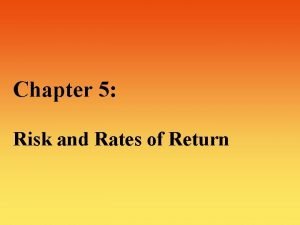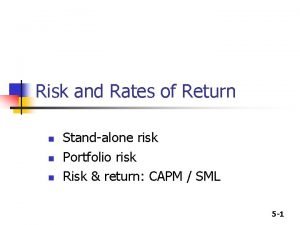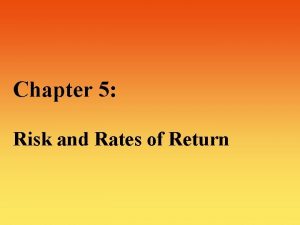Introduction risk and return Risk is an important
























- Slides: 24

Introduction: risk and return • Risk is an important factor in financial decision making • Investors are generally risk averse they demand compensation for bearing risk • Most investor don’t put all their eggs in one basket • We discount the future cash flows for time value of money and degree of risk to choose among investment decisions • The management’s primary goal is stockholder wealth maximization which translates into maximizing the price of the common stock.

What is risk ? • Risk is the uncertainty of future cash flow , it can be measured by the standard deviation of probability distribution of stock returns

Systematic risk versus unsystematic risk • We can measure risk by dispersion of possible outcomes around the expected return • Total risk =Market risk +Unique risk • Unique risk is known as diversifiable risk (unsystematic ) • Market risk is unavoidable component of risk

Risk Types § The risk (variance) on any individual investment can be broken down into two sources. Some of the risk is specific to the firm, and is called firmspecific, whereas the rest of the risk is market wide and affects all investments. § The risk faced by a firm can be fall into the following categories (1) Project-specific; an individual project may have higher or lower cash flows than expected. (2) Competitive Risk, which is that the earnings and cash flows on a project can be affected by the actions of competitors. (3) Industry-specific Risk, which covers factors that primarily impact the earnings and cash flows of a specific industry. (4) International Risk, arising from having some cash flows measured in currencies other than the one in which the earnings are measured (5) Market risk, which reflects the effect on earnings and cash flows of macro economic factors that essentially affect all companies • In 1987 around 95 %of stocks traded on the New York stock exchange dropped in price

The Effects of Diversification § Firm-specific risk can be reduced, if not eliminated, by increasing the number of investments in your portfolio (i. e. , by being diversified). Market-wide risk cannot. This can be justified on either economic or statistical grounds. § On economic grounds, diversifying and holding a larger portfolio eliminates firm-specific risk for two reasons (a) Each investment is a much smaller percentage of the portfolio, muting the effect (positive or negative) on the overall portolio. (b) Firm-specific actions can be either positive or negative. In a large portfolio, it is argued, these effects will average out to zero

The Market Portfolio § Assuming diversification cost nothing (in terms of transactions cost), and that all assets can be traded, the limit of diversification is to hold a portfolio of every single asset in the economy (in proportion to market value). This portfolio is called the market portfolio. § Individual investors will adjust for risk, by adjusting their allocations to this market portfolio and a riskless asset (such as a T-Bill) Preferred risk level Allocation decision No risk 100% in T-Bills Some risk 50% in T-Bills; 50% in Market Portfolio; A little more risk 25% in T-Bills; 75% in Market Portfolio Even more risk 100% Market Portfolio Highest risk. . Borrow money; Invest in market portfolio; § Every investor holds some combination of the risk free asset and the market portfolio.

Market risk and unique risk : Effect of diversification Risk Unique risk Market risk Number of shares

Market risk and Beta • Beta (β) measure the sensitivity of a an asset return to market movement (systematic risk ) • Estimating beta : Stocks beta are usually estimated from historical data based on expectations about future performance relative to market

Riskfree Rate § On a riskfree asset, the actual return is equal to the expected return. Therefore, there is no variance around the mean. § The riskfree rate is the rate on a zero coupon government bond matching the time horizon of the cash flow being analyzed. There has to be no default risk, which generally implies that the security has to be issued by the government. however, that not all governments can be viewed as default free. § Theoretically, this translates into using different riskfree rates for each cash flow – the 1 year zero coupon rate for the cash flow in year 1, the 2 -year zero coupon rate for the cash flow in year 2 … § On reality , there is nothing without bearing risk.

The Capital Asset Princing Model § Uses variances as a measure of risk § Specifies that a portoin of variance can be diversified away, and that is only the non-diversifiable portion that is rewarded. § Measures the non-diversifiable risk with beta, which is standardized around one. § Translates beta into expected return – Expected Return = Riskfree rate + Beta * Risk Premium

Assumptions of CAPM • 1 -Efficient market: Securities market is highly competitive and populated by highly informed buyers and sellers • 2 -Securities market are dominated by rational, risk averse investors, who seek to maximize their returns and they demand a premium in the form of higher expected return from bearing risk • 3 - Financial market are frictionless : there are no tax , transaction cost or restriction on borrowing and lending

Measurement of the risk premium § The risk premium is the premium that investors demand for investing in an average risk investment, relative to the riskfree rate. § As a general proposition, this premium should be greater than zero increase with the risk aversion of the investors in that market increase with the riskiness of the „average” risk investment.

Estimating Risk Premiums in Practice § Survey approach : investors asked about their desired risk premiums and use the average premium from these surveys. § Assume that the actual premium delivered over long time periods is equal to the expected premium – i. e. , use historical data § Estimate the implied premium in today’s asset prices.

historical premiums approach § For instance Ibbotson estimates the following premiums for major markets from 1970 -1996 Country Australia France Germany Italy Japan Mexico Singapore Spain Switzerland UK Stock return 8. 47% 11. 51% 11. 30% 5. 49% 15. 73% 11. 88% 15. 48% 8. 22% 13. 49% 12. 42% Bond Return 6. 99% 9. 17% 12. 10% 7. 84% 12. 69% 10. 71% 6. 45% 7. 91% 10. 11% 7. 81% Risk Premium 1. 48% 2. 34% -0. 80% -2. 35% 3. 04% 1. 17% 9. 03% 0. 31% 3. 38% 4. 61%

Portfolio Theory and CAPM Efficient portfoliós Efficient portfolios after introducing risk free investment Yield CML rf Std. dev. CAPM Yield SML rf sp Std. dev. Beta 1 Beta Portfolio beta

Limitations of the CAPM 1. 2. 3. The model makes unrealistic assumptions The pareameters of the model cannot be estimated precisely - Definition of a market index - Firm may have changed during the ‘estimation’ period’ The model does not work well - If the model is right, there should be a linear relationship between returns and betas the only variable that should explain returns is betas - The reality is that the relationship between betas and returns is weak Other variables (size, price/book value) seem to explain differences in returns better.

Financial decision making: the capital structure decision § Invest in projects that yield a return greater than the minimum acceptable hurdle rate. The hurdle rate should be higher for riskier projects and reflect the financing mix used – owners’ funds (equity) or borrowed money (debt) Returns on projects should be measured based on cash flows generated and the timing of these cash flows; they should also Choose a financing mix that minimizes the hurdle rate and matches the assets being financed.

The Cost of Raising Funds § Issuing new equity is much more expensive than raising new debt for companies that are already publicly traded, in terms of transactions costs and investment banking fess. § Raising small amounts is much more expensive than raising large amounts, for both equity and debt

Weighted average cost of capital • WACC: is the minimum acceptable rate of return at which a company yields returns for its investors • WACC is an investor’s opportunity cost of taking on the risk of investing money in a company • We used WACC for proper investment decision making whether or not an investment is worth pursuing

Measuring Cost of Capital § It will depend upon: (a) the components of financing: Debt, Equity or Preferred stock (b) the cost of each component § the cost of capital is the cost of each component weighted by its relative market value. Where, D : total debt E : total equity r e: interest rate of debt r d: expected yield of equity

Cost of Capital: using the Dividend growth model •

Cost of Capital: using the Dividend growth model •

Why we calculate the WACC • To assess the value of investments • WACC used as a hurdle rate against which companies and investors can gauge return on investment • WACC is also essential to perform economic value-added (EVA) calculations. • WACC used as an indicator of whether or not an investment is worth pursuing

• THANK YOU
 Introduction to risk and return
Introduction to risk and return Risk and return
Risk and return The risk per unit of return is measured by the
The risk per unit of return is measured by the Risk and return
Risk and return Multifactor model of risk and return
Multifactor model of risk and return Financial management chapter 8 risk and return
Financial management chapter 8 risk and return Chapter 13 return risk and the security market line
Chapter 13 return risk and the security market line Risk and return
Risk and return Chapter 8 risk and rates of return problem solutions
Chapter 8 risk and rates of return problem solutions Capital market line
Capital market line Contoh soal risk and return
Contoh soal risk and return Difference between risk and return
Difference between risk and return Chapter 5 risk and return
Chapter 5 risk and return Difference between risk and return
Difference between risk and return Risk and return
Risk and return Konsep risk and return
Konsep risk and return Liquidity measures
Liquidity measures From most important to least important in writing
From most important to least important in writing From most important to least important in writing
From most important to least important in writing Least important to most important
Least important to most important Markowitz model of risk return optimization
Markowitz model of risk return optimization Risk return principle
Risk return principle Risiko portofolio adalah
Risiko portofolio adalah Module 4: investing test answer key
Module 4: investing test answer key Pengertian investasi
Pengertian investasi
